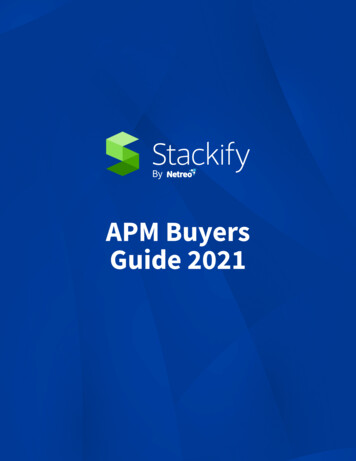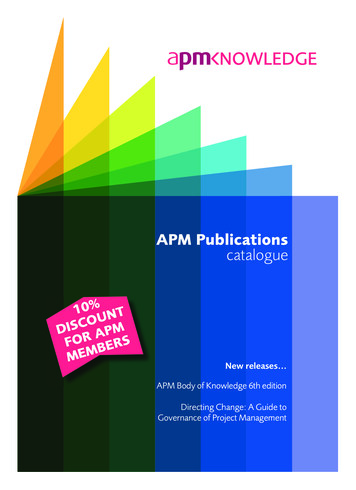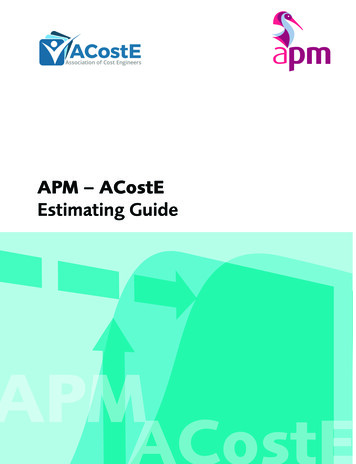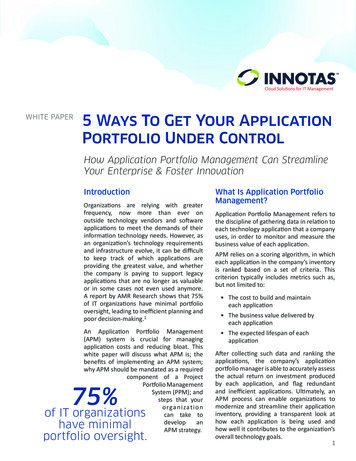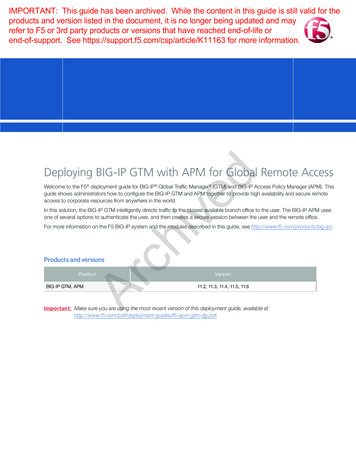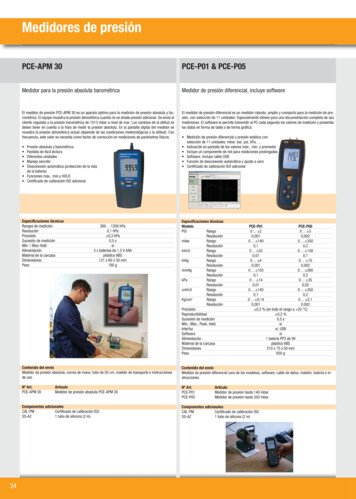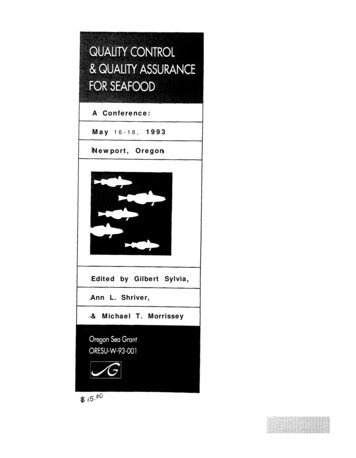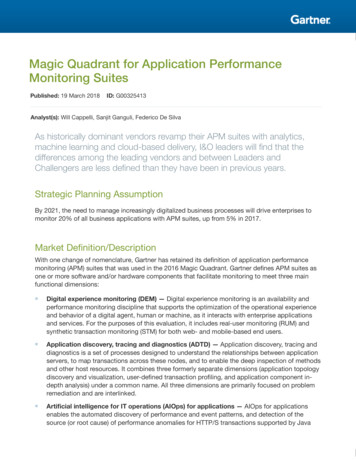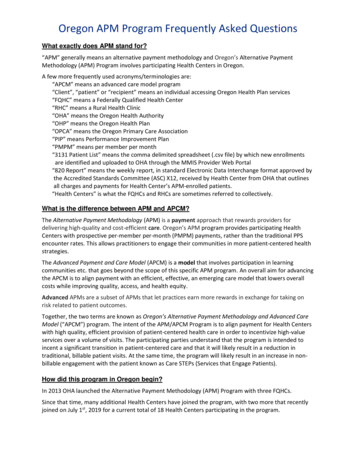
Transcription
Oregon APM Program Frequently Asked QuestionsWhat exactly does APM stand for?“APM” generally means an alternative payment methodology and Oregon’s Alternative PaymentMethodology (APM) Program involves participating Health Centers in Oregon.A few more frequently used acronyms/terminologies are:“APCM” means an advanced care model program“Client”, “patient” or “recipient” means an individual accessing Oregon Health Plan services“FQHC” means a Federally Qualified Health Center“RHC” means a Rural Health Clinic“OHA” means the Oregon Health Authority“OHP” means the Oregon Health Plan“OPCA” means the Oregon Primary Care Association“PIP” means Performance Improvement Plan“PMPM” means per member per month“3131 Patient List” means the comma delimited spreadsheet (.csv file) by which new enrollmentsare identified and uploaded to OHA through the MMIS Provider Web Portal“820 Report” means the weekly report, in standard Electronic Data Interchange format approved bythe Accredited Standards Committee (ASC) X12, received by Health Center from OHA that outlinesall charges and payments for Health Center’s APM-enrolled patients.“Health Centers” is what the FQHCs and RHCs are sometimes referred to collectively.What is the difference between APM and APCM?The Alternative Payment Methodology (APM) is a payment approach that rewards providers fordelivering high-quality and cost-efficient care. Oregon’s APM program provides participating HealthCenters with prospective per-member per-month (PMPM) payments, rather than the traditional PPSencounter rates. This allows practitioners to engage their communities in more patient-centered healthstrategies.The Advanced Payment and Care Model (APCM) is a model that involves participation in learningcommunities etc. that goes beyond the scope of this specific APM program. An overall aim for advancingthe APCM is to align payment with an efficient, effective, an emerging care model that lowers overallcosts while improving quality, access, and health equity.Advanced APMs are a subset of APMs that let practices earn more rewards in exchange for taking onrisk related to patient outcomes.Together, the two terms are known as Oregon’s Alternative Payment Methodology and Advanced CareModel (“APCM”) program. The intent of the APM/APCM Program is to align payment for Health Centerswith high quality, efficient provision of patient-centered health care in order to incentivize high-valueservices over a volume of visits. The participating parties understand that the program is intended toincent a significant transition in patient-centered care and that it will likely result in a reduction intraditional, billable patient visits. At the same time, the program will likely result in an increase in nonbillable engagement with the patient known as Care STEPs (Services that Engage Patients).How did this program in Oregon begin?In 2013 OHA launched the Alternative Payment Methodology (APM) Program with three FQHCs.Since that time, many additional Health Centers have joined the program, with two more that recentlyjoined on July 1st, 2019 for a current total of 18 Health Centers participating in the program.
Oregon APM Program Frequently Asked QuestionsWhat is the payment methodology for this program?OHA agrees to pay participating Health Centers PMPM payments each month. OHA pays a prorated dailyPMPM amount for individuals added or deleted from Health Center’s APCM Program during the month.Open Card Patients also referred to as Fee-for-Service (FFS) Patients are included in the APCM program,and a unique Open Card rate is established.What types of data collection and data tracking is involved in APM?APM Quality Metrics Overview:OHA tracks five metrics on a quarterly basis for APM-enrolled FQHCs that have been aligned with theCoordinate Care Organization (CCO) incentive measures, in order to hold Health Centers accountable forthe quality of care (and provide comparative analysis to their contracted CCOs performance).Quality Metric Reports currently capture the following CCO incentive measures:Quality MetricsColorectal Cancer ScreeningDepression ScreeningDiabetes Poor ControlWeight Assessment and Counseling in Childrenand AdolescentsHypertensionAPM-participating Health Centers report the above required CCO measures for Medicaid patients at theHealth Center. The CCO aggregate performance average (CCO average), when available, will serve as thetarget value for each quality metric. OPCA and OHA work to update target values each July to reflectannual averages in the prior calendar year, which are published annually in OHA’s CCO Metrics Report.Patient Experience Reporting for APM:APM Health Centers are required to report CAHPS data to OHA as part of the quality quadrant of theAPCM Accountability Plan, agreed to with OPCA, and OHA. Two questions are included on the PatientExperience report, both of those required questions are taken from the CAHPS Adult 3.0 survey, whichreflect the results for the Health Center’s entire patient population.For now, the questions are ‘report only’ and are not held to a performance standard. Ideally, datacollection methods will become standardized across the APM program so that the results arecomparable to each other. In the meantime, Health Centers are expected to make a good faith effortand to continue working with OPCA and OHA to come into alignment around the data collectionmethods used, frequency of surveying, and the lookback period for CAHPS Q6. If CCO requirementschange, both parties may re-open the APM participation agreement in order to re-establish alignment.Care STEPs (Care and Service That Engage Patients):OHA also collects quarterly Care STEPs Reports (previously called ‘Touches’) from APM Health Centers(which includes column for tally of UDS visits). A Care STEP is a specific direct interaction between theHealth Center staff and the patient, the patient’s family or authorized representative(s) through inperson, digital, group visits, or telephonic means.There are currently 18 Care STEPs, grouped into four categories:1) New Visit Types,2) Education, Wellness and Health Promotion,
Oregon APM Program Frequently Asked Questions3) Coordination and Integration, and4) Reducing Barriers to HealthCare STEPs documentation can demonstrate the range of ways in which Health Center teams areproviding access to services and value to patients. Care STEPs data are collected and submitted quarterlyto OHA, in order to better understand the non-billable and non-visit-based care and services that arebeing delivered, as the Patient-Centered Primary Care Home model advances under APCM.Payment reconciliation Reporting for APM:When a health center is paid using a capitation (alternative payment, APM) methodology, participatinghealth center complete a quarterly reconciliation comparing revenue earned under the APM Programwith revenue it would have earned under traditional PPS, in accordance with OAR 410-147-0460, andOAR 410-147-0360:(19) For an FQHC approved by the Division to participate in an Alternate Payment Methodology(APM) pilot, the following will apply:(a) APM converts the clinics current PPS rate into an equivalent per member per month (PMPM)rate using the clinic’s historical patient utilization and the clinic’s PPS cost base rate. The purposeof APM is to reimburse clinics an amount no less than what the clinic would have received if paidwith PPS. The Division shall process quarterly reconciliations and if the APM issued is less thanwhat the clinic would have received if paid using PPS, the Division shall reimburse the clinic thedifference. The Division will perform a final annual reconciliation and remit payment within 120days after the close of the calendar year.The reconciliation is intended to assure that the APM payment is at least as much as the PPS paymentswould have provided for the same time period. The Health Center participating in APM is required toreport all payments of amounts reflected on an EOB and received for the provision of health services toOregon Health Plan members, including capitation and any and all payments received by the FQHC/RHCfrom private insurance or any other coverage, as well as including Medicare MCO supplementalpayments, Medicare Advantage Managed Care Organizations (MCO), any Third Party Resource(s) (TPR),total payments for all services submitted to the Prepaid Health Plans (PHP), including laboratory,radiology, nuclear medicine, and diagnostic ultrasound; and excluding any bonus or incentive payments.How is accountability addressed within this program?In 2017 OHA, OPCA and participating Health Centers agreed to an accountability plan entailing anexplicit measurement strategy, in which the Health Center agrees to submit data to OHA and OPCA (andparticipate in process workgroups that advances operationalization of developmental reportingrequirements).In 2018 OHA, OPCA, and Health Centers reached agreement about the construct of this risk proposal.The technical implementation details determined by the workgroup included: The process for incorporating future targets and measures The process for implementing rate reductions The details about how a clinic exits the penalty period The implementation timeline that considers clinic phaseHealth Center that participate agree to report CCO measures for Health Center’s APM Eligible OHPpatients. Failure to submit the list of required measures and improvement targets by the agreed upondeadline may trigger a Performance Improvement Plan (PIP).
Oregon APM Program Frequently Asked QuestionsWhat services are included in APM (meaning carved-in the) program?The ‘Client Start Date’ is considered the effective/start date (date when a Health Center participating onAPM has had an establishing visit with the patient (further outlined in APM Participation Agreements).“APCM Establishing Visit” means a face-to-face interaction with the patient (including a traditional officevisit, home visit, group visit, virtual, or Telemedicine Visit) that includes, at minimum, a medical history,problem list review, and medication and allergy review or any other medical encounter as defined inOAR 410-147-0120 that constitutes a carved-in APCM service. In the case of a virtual or TelemedicineVisit, the visit must be a “synchronous (live two-way interactive) video transmission resulting in real timecommunication.” Telemedicine Visits must be in accordance with OAR 410-130-0610 “Telemedicine”.An Establishing Visit shall be provided by a Health Care Professional acting within the scope of his/herpractice, certification, or licensure as defined in OAR 410-120-0000 (100)On the date of service of a visit meeting the criteria above of an establishing visit, the patient/clientmust also have an eligible Oregon Health Plan benefit packages: (1) BMH: OHP Plus; (2) BMM: QualifiedMedicare Beneficiary and OHP with Limited Drug; (3) BMD: OHP with Limited Drug; and (4) CWX:Prenatal Expansion for CAWEM clients., and (5) any other OHP benefit package that OHA may createthat results in a PMPM Payment.In order to be considered an “Eligible Patient” that’s included, confirmed on the APCM EnrollmentReport and added to Health Center’s APCM Program, that client must:1. Have a valid OHP ID number; and2. Have been provided a face-to-face medical encounter (office visit) in the prior 18 months atthe Health Center (or, in the period following the creation of the Day One List, have beenprovided an APCM Establishing Visit (which includes a billable medical office visit, during a 12month look back period). Health Center is prohibited from using an 18 month look back foran APCM Establishing Visit after the “Day-One” patient list is loaded through the MMISProvider Web Portal.3. After the “Day-One” list, Health Center shall use a 12-month look back for an APCMEstablishing Visit.4. Be attributed to Health Center after adjusting for attribution and leakage (e.g., patientsoverlapping with other FQHCs, RHCs, or primary care providers).Patient Engagement: A patient who is included on Health Center’s APCM Enrollment Report assuccessfully enrolled remains an “Eligible Patient” for which Health Center receives a PMPM payment(and “Eligible PMPM Patient”) so long as (a) the patient is covered by OHP, (b) the Health Centerprovides the patient with at least one visit or Care STEP every 8 quarters (such 8-quarter period referredto as the “Engagement Period”), and (c) patient has not become a “Leaked Patient”A “Leaked Patient” is a patient who is included in Health Center’s APCM Program but whoseAPCM enrollment ends due to the patient receiving one Primary Care Visit by another OregonMedicaid enrolled provider that qualifies for PPS payments or at least two Primary Care Visits byanother provider that does not qualify for PPS payments (in all cases, a “Disqualifying Visit”).PMPM payments to Health Center with respect to a Leaked Patient stop as of the date of theearliest Disqualifying Visit for each of the two scenarios.Day-One List: Health Center shall prepare and upload a “Day One” patient list, which is the list ofpatients for which the Health Center is eligible to be reimbursed an APCM Rate effective the first monthof Health Center’s participation in the Program (the “Day-One List”) if the patients are eligible for theOregon Health Plan and not enrolled with a separate participating Health Center. Health Center mayload its Day-One List through the MMIS Provider Web Portal.
Oregon APM Program Frequently Asked QuestionsWhat services are not included in APM (meaning excluded, carved-out of the) program?The APM per-member per-month (PMPM) rate payments exclude specific services that will continue topay at the PPS rate (until they are carved-in).These services are:- Dental Services- Mental Health/Addictions Services- Prenatal/OB Services- Maternity Case Management ServicesWhen a claim is billed by an APM provider for a service that is carved-out of the APM PMPM rates, theclaim will process as it normally would under the PPS payment methodology.When a claim is billed for a service that is carved-in to the APM PMPM rates (medical/primary care), thesystem will zero pay ( 0) the claim. Other types of claims that have 0 paid before APM are situationswhere multiple encounters occur on the same date of service (see OAR 410-147-0140 "MultipleEncounters") OR services inclusive of the PPS encounter rate (see OAR 410-147-0120 "DivisionEncounter and Recognized Practitioners").For APM carved-in services, the only difference in claims processing is that paid claims will be paid 0.Carved-Out CPT & Diagnosis Codes: For FFS claims, MH/Addictions carved-out diagnosis codes will bepaid the PPS rate based on the primary MH/Addictions diagnosis code on the claim.Dental procedure codes (procedure codes beginning with 'D') will pay at the PPS encounter rate basedon preexisting FQHC/RHC reimbursement policy.Most Prenatal/OB code combinations need to be billed with the 'U1' modifier to be paid at the PPS rate.In Attachment F of the APM Participation Agreement, the specific procedure and diagnosis codecombinations (where necessary) that when billed will be paid at the PPS rate (along with other billingrules being considered) are listed for participating Health Centers.How does an existing Health Center participate in this program?The Participation Agreement (“Agreement”) describes the terms of participation in Oregon’s AlternativePayment Methodology and Advanced Care Model (“APCM”) program (the “Program” or the “APCMProgram”) for Federally Qualified Health Centers (“FQHCs") and Rural Health Clinics (“RHCs”) and therespective obligations of the FQHCs and RHCs and OHA.The Program parameters are guided by the Oregon State Plan Amendment (“SPA”) Transmittal # 12-08,Attachment 4.19-B; Methods and Standards for Establishing Payment Rates: Alternate PaymentMethodology, approved on 9/12/12 by CMS and OAR 410-147-0360.An existing Health Center interested in joining would being by going through processes involvingassessment tools, surveys and webinars to discuss and determine readiness with their current model,prior to opting-in, to then proceed with rate calculations and determinations.Those whom are interested can also learn more by visiting OPCA’s APCM webpage are-model
What is the difference between APM and APCM? The Alternative Payment Methodology (APM) is a payment approach that rewards providers for delivering high-quality and cost-efficient care. Oregon's APM program provides participating Health Centers with prospective per-member per-month (PMPM) payments, rather than the traditional PPS encounter rates.
